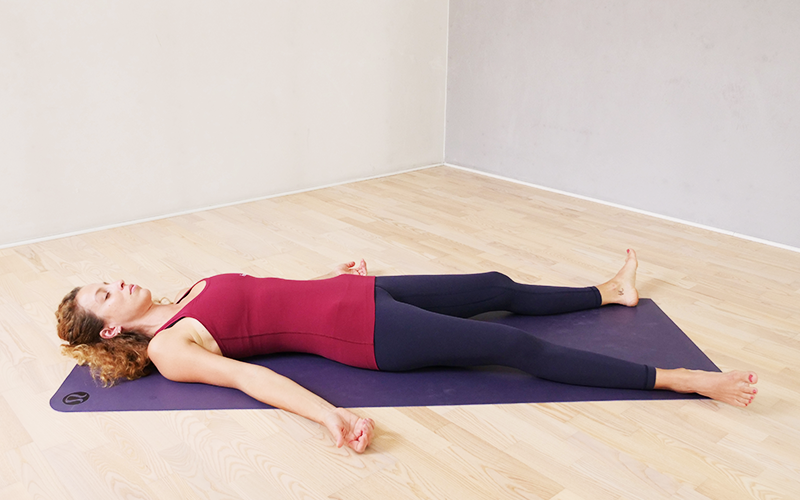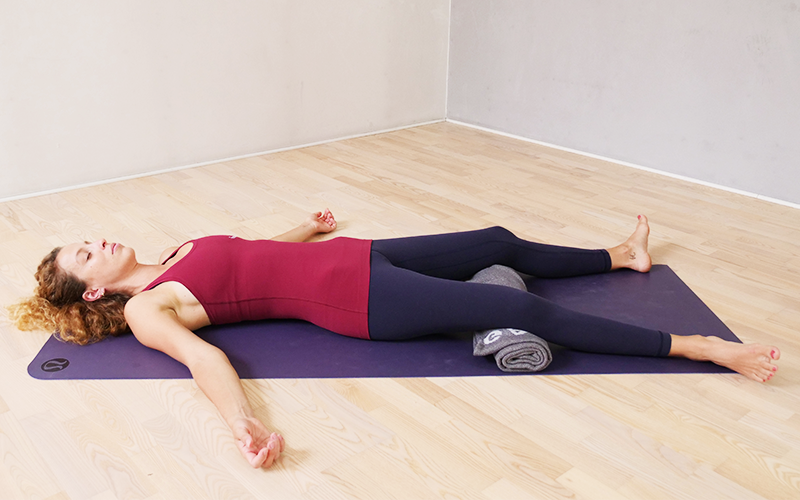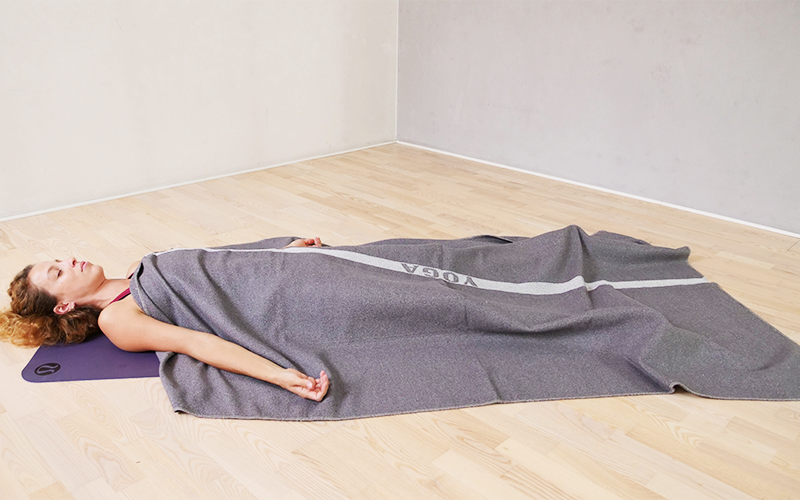Savasana: More than just a nap!
 ©foodspring
©foodspring
While savasana may not be very physically demanding, it’s a yoga pose you definitely shouldn’t skip. Here, we explain why it’s more than just a glorified nap, as well as all the benefits you might experience from incorporating it into your yoga practice.
What is savasana?
Savasana is a word in Sanskrit that literally translates to “corpse pose”. Taking place at the end of your yoga session, it’s a resting pose that can last anywhere from 5 to 20 minutes — however long you see fit. During this time, you simply lie on your back with your eyes closed and body relaxed, like a corpse. Rather than taking this opportunity to have a power nap, the goal is to turn your mind inward as you would in meditation. Let worries about your day and all the things you have to do slip away as you focus on the moment and the way you feel in your body after all that hard work. Of course, doing this is often easier said than done, and quieting the mind can be especially difficult for some yoga students.
If you struggle with controlling your thoughts during savasana, try to stand back and observe them instead. Think of them as cars in traffic while you are seated on the side of the road watching them go by. Doing this while you’re focused on moving from one posture to the next may be easy, but it can sometimes feel impossible when you’re just lying on your mat.
Savasana is a great opportunity to let the effects of your yoga practice kick in. Notice the way your muscles feel different than they did before your workout. Scan yourself from the bottom up, examining each individual body part from your toes to your forehead. Focus on the way your breath moves into and expands different muscles.
Ideally, having this mental practice will make it easier to regain your relaxed yoga state during the stress of daily life. The next time your thoughts feel like they’re spinning out of control, take a moment for yourself to be mindful. After your yoga practice, you may find that it’s easier to go on with your day.
Benefits of savasana
A well-designed yoga class usually has a purpose that’s reflected in the selection and flow of asanas—the various so-called yoga poses. In savasana, the goal is to perceive the silence around and within you and fully feel the effects of the previous poses. Properly practiced, savasana can have many benefits.
Savasana…
- releases tension.
- lowers the heart rate.
- calms the central nervous system.
- helps release stress and reduce stress hormones.
- promotes the release of happiness hormones.
- circulates energy throughout the body.

Tips for Total Relaxation in Savasana
1. Make yourself comfortable.
Lie down in a way that allows you to really relax. Neck is long, Legs and arms are slightly opened, palms are facing the sky, and toes fall to the side. Shoulder blades are relaxed and every part of the body is resting heavily on the floor.
Our tip: Place a rolled up blanket under your knees for extra support. Using blankets, props, or modifications like this will allow your legs and lower back to relax more. You can also use a pillow for your head or under your butt if you have a natural arch.
2. Let go for good.
Close your eyes, both physically and mentally. Consciously relax every part of your body, one after the other. Relax the muscles in your face, let your forehead soften, relax your jaw, free your tongue from the roof of your mouth. Sink your back into the floor a little more with each breath.
Our tip: Before doing a corpse pose, stretch and engage your body one more time. Clench your fists, lift your arms and legs off the floor, tense your face. As you breathe out, release it all and feel the immediate difference.
3. Scan your body.
If you’re having trouble centering yourself, try to refocus by scanning your body from top to bottom. Check in with each individual muscle and limb to make sure that nothing is unnecessarily tense or stressed.
4. Don’t put too much pressure on quieting your mind.
You may not have trouble clearing your mind until the moment you start focusing too hard on doing it. The goal with this pose isn’t to empty your mind automatically, but instead to train it so that you improve a little each time. It’s not about not thinking, but about not letting your thoughts get to you. Just let them flow on past rather than getting attached to them. The more you do it, the easier it will become.
Our tip: If you have trouble doing this, try focusing on your breaths or on a mantra.
5. Accept what is.
Not every savasana is the same. Some days our minds are more restless than others. While you may have no problem emptying your mind one day, it may feel impossible to do it the next. Be aware of how you’re feeling and don’t put too much pressure on yourself to stay focused. It’s not important to do it perfectly, but to at least try to no matter what state you’re in.
©foodspring
The savasana checklist
Here’s a checklist for a successful savasana:
- Your feet are relaxed, your toes fall slightly to the sides.
- Your legs are hips-width apart.
- Your back is flat on the floor, your spine extended.
- Your arms and shoulders are relaxed away from the body.
- Your chin is slightly tilted towards your chest.
- Your joints are relaxed.
- The muscles in your face, tongue, jaw, and eyes are relaxed. Leave your mouth slightly open to help relax the jaw.
- Concentrate on your breath, your body, or your mantra.
- Slowly come out of the savasana posture by gently moving your limbs. Stretch your body and turn to lie on your right side for a moment.
Tips for doing savasana properly
Wondering how you could possibly mess up lying on your back? While it’s true that there aren’t many ways to hurt yourself in savasana, it is possible that you do so in other poses, and having an injury may inhibit your ability to relax in the final pose.
Here are two tips to improve your savasana and maximize its effect:
- Don’t block your thoughts. Just be an observer of them. Focus on your body and your breath. Let your them go, accept them, and stay still.
- Take the time you need to slowly come out of the corpse pose. Breathe deeply and begin by moving your toes and fingers. Reach your arms over your head and stretch. Roll onto your right side and lie there for a moment. Then slowly straighten up with the strength of your arms and sit cross-legged with your eyes closed for a moment. Take this time to thank your body for the class. Namaste.
Savasana: Our conclusion
- Savasana is a Sanskrit word that means “corpse pose.”
- It’s normal to do corpse pose at the end of yoga classes.
- Remaining physically and mentally immobile while lying down is the difficult part—not unlike in meditation.
- The goal is to release all the tension in your body after your workout and relax your body and mind.
- Savasana can allow you to relax and let go of stresses.
- Some of the benefits include a relaxed nervous system and increased well being.
Sources for this article
We at foodspring use only high-quality sources, including peer-reviewed studies, to support the facts within our articles. Read our editorial policy to learn more about how we fact-check and keep our content accurate, reliable, and trustworthy.

































